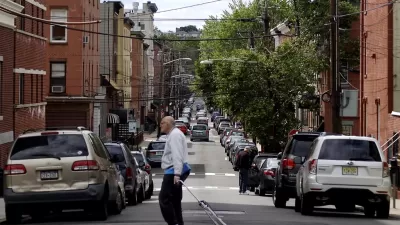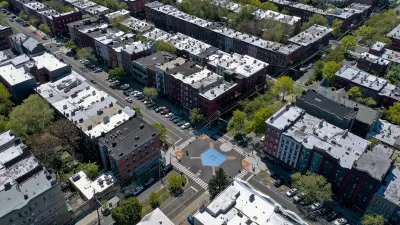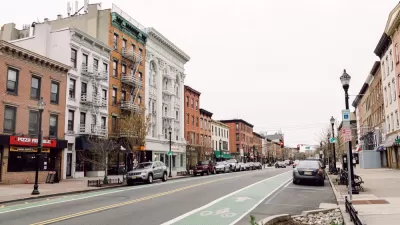As young planners bursting into the real world we are anxious to create communities that are vibrant, fun, and speak to the urbanity that will host future generations of our civilization. What we lack in experience we make up for in enthusiasm, and hope that our superiors guide us on the finer points of less crystallized aspects of critical infrastructure such as designing for the elderly, disabled, and those semi-attached to a stroller. In traffic engineering, we often hear a common rebuttal to technical traffic analysis from communities; they say, “I drive these streets every day, so I understand traffic here better than you.” Well, they’re right.
- Driving everywhere sucks. While there's something to be said for the sterile shuttling of babies to and fro via a car, getting past the psychological hurdle of daily life sans auto clears the way for an incredibly enjoyable father-child interaction that simply cannot be attained between front and rear seat. City streets provide tons of entertaining sights, people, and words to repeat (repeatedly), like building, people, plane, bus, truck, bicycle, baby, etc, and no DVD player is required! Also, it's amazing that I think this way nowadays, but not having to drive to the food store, the pharmacy, doctor's office, restaurants and other errands makes me feel like I am minimizing my son's risk with one of the greatest killers in America, car accidents.
- Playtime is an even split between toys at home and the local park playground. The debate about putting our son in day care versus a nanny (that translates to social stimulation versus personal interaction for non-parents) is dramatically skewed by the fact that our community playground is a two block walk away and puts our son amongst all kinds of kids and all ages. He meets new kids all the time and recognizes friends (or at least we do). Anhana from India and Finn from Germany are testaments to the diverse cultural exposure urban kids have, which I feel is really important to fostering a sense of equality for children. Sure you may find this in a day care, but the bustling urban playground is free!*
- Transit is still not so stroller friendly. While it is certainly possible to get around on transit with a stroller, there are often impediments and delays that make it less than ideal. In New York City, expect to schlep strollers up/down subway stairs or find a walking route. Across the Hudson in my hometown of Hoboken, the light rail is easy to board/alight but the PATH train still requires a tucked away elevator trip that feels like the visual accoutrement to the final audio seconds of Pink Floyd's "Welcome to the Machine" track.
- Narrow sidewalks with tree pits, utility poles, and other installations that reduce the effective width are challenges, as are corners with no or deficient ramps and crosswalks. And whilw we're talking about crosswalks, there must be a shift in street design to make the traveled way the decorative paver brick or Belgian bock and the crosswalk a smooth surface, not the other way around which has happened in many cities at the expense of those who have trouble walking.
- The bicycle is the car. It's amazing how easy and fun it is for kids to tag along with parents on cruises or errand runs when sitting in a bicycle seat. Open to fresh air, navigating through the mix of activities, and not staring at a car seat are all good reasons to take to two wheels with kids.
- Unscheduled, frequent interaction with friends, neighbors, neighbors' dogs, and new parents is an entirely unique urban experience. This is by far the most enjoyable aspect of living with kids in the city. A casual walk on the street or in the park is rife with casual encounters that lead to all kinds of new relationships and knowledge. We recently made friends with a young family who was walking by our outdoor table at a pizzeria. You simply can not and do not get the same exposure from a trip to the shopping mall or waving at your neighbors as you drive by their yard.

Alabama: Trump Terminates Settlements for Black Communities Harmed By Raw Sewage
Trump deemed the landmark civil rights agreement “illegal DEI and environmental justice policy.”

Study: Maui’s Plan to Convert Vacation Rentals to Long-Term Housing Could Cause Nearly $1 Billion Economic Loss
The plan would reduce visitor accommodation by 25% resulting in 1,900 jobs lost.

Planetizen Federal Action Tracker
A weekly monitor of how Trump’s orders and actions are impacting planners and planning in America.

Wind Energy on the Rise Despite Federal Policy Reversal
The Trump administration is revoking federal support for renewable energy, but demand for new projects continues unabated.

Passengers Flock to Caltrain After Electrification
The new electric trains are running faster and more reliably, leading to strong ridership growth on the Bay Area rail system.

Texas Churches Rally Behind ‘Yes in God’s Back Yard’ Legislation
Religious leaders want the state to reduce zoning regulations to streamline leasing church-owned land to housing developers.
Urban Design for Planners 1: Software Tools
This six-course series explores essential urban design concepts using open source software and equips planners with the tools they need to participate fully in the urban design process.
Planning for Universal Design
Learn the tools for implementing Universal Design in planning regulations.
Caltrans
Smith Gee Studio
Institute for Housing and Urban Development Studies (IHS)
City of Grandview
Harvard GSD Executive Education
Toledo-Lucas County Plan Commissions
Salt Lake City
NYU Wagner Graduate School of Public Service






























